Big telescopes lead to big discoveries. Or so you would assume. After the general success of Lord Rosse’s 72-inch reflector, a group of leading British and Irish astronomers championed the cause of building a large telescope in the Southern Hemisphere. The resulting 48-inch f/41 Great Melbourne Telescope (GMT) – the second largest in the world – began service in 1869. The father and son Irish telescope engineers Thomas and Howard Grubb built an innovative Cassegrain optical design, open-lattice tube to avoid tube currents, and an equatorial mount with a weight-driven clock drive. Expectations were sky high for spectacular discoveries.
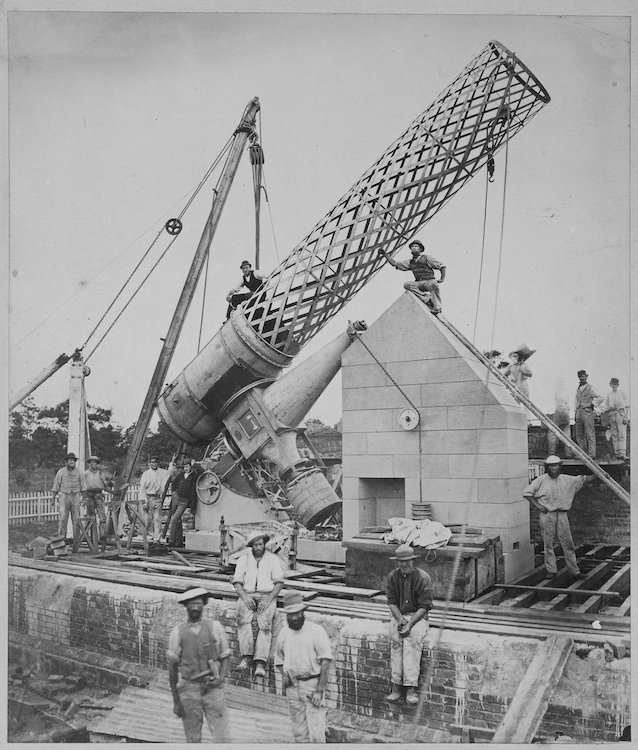
Erecting the Great Melbourne Telescope, 1869 (Credit: Museums Victoria)
Thirty-five years earlier John Herschel surveyed the southern skies with his 18.5-inch f/13 speculum reflector from the Cape of Good Hope in South Africa. Herschel produced a monumental catalog of over 1700 southern nebulae and clusters, nearly 1300 seen for the first time, and a list of over 2000 double stars. Herschel also compiled an extensive catalog of the stars, clusters, and nebulae in the Magellanic Clouds and documented spectacular outbursts of the variable star Eta Carinae. The nature of the fuzzy nebulae was a vexing problem – were they unresolved star clusters or self-luminous matter?
The GMT produced a few early photographs of the Moon and southern nebulae and experimented with spectroscopy, but the telescope was poorly designed for these new fields. Its primary mission, as determined by the Royal Society committee, was to document changes in the structure of the mysterious nebulae. Herschel’s published sketches served as the reference. From the onset, various issues arose with the operation of the telescope and the observing program. The staff used the wrong solvent to remove a shellac coating that protected the mirror surface during transport. As a result, the primary mirror displayed a “mealy” appearance and required repolishing. Someone removed the eye-stops (baffles) from the supplied eyepieces, and their performance was poor.
Even after rectifying these mistakes, larger problems surfaced because of a poor site location and lack of a dome. Only a few moonless nights a month were useable for critical viewing. Wind caused the structure to vibrate and the massive mirror – the last large speculum built – tarnished rapidly in the moist Melbourne weather.
The observatory struggled to hire and maintain first-class visual astronomers. Variability in observing conditions and the subjective nature of recording and sketching details near the limit of visibility led to inconclusive results. The astronomers were unaware that the targeted objects (both emission nebulae and galaxies) were much too distant to display any physical changes over a few decades. A series of poor decisions and unfortunate timing doomed the project’s mission from the start.
Robert Ellery, the director of the observatory, published one major paper on the results: “Observations of the Southern Nebulae made with the Great Melbourne Telescope from 1869 to 1885. Part I. Melbourne”. Ellery included sketches and descriptions of many nebulae but mentioned only two discoveries by Pietro Baracchi, and both were insignificant finds. Despite the expectation to publish later observations, lack of both financial resources and an effective method to produce lithographs of the sketches squashed that goal. Was it possible the observers discovered only two measly objects with the 48-inch GMT?
George Ritchey, the architect of the 60-inch and 100-inch Mt. Wilson reflectors, considered the GMT an abject failure and wrote it was “one of the greatest calamities in the history of instrumental astronomy; for by destroying confidence in the usefulness of great reflecting telescopes, it has hindered the development of this type of instrument… for nearly a third of a century.”
The GMT was in active service in Melbourne for nearly 20 years. While reexamining known objects, I felt it was likely the observers noticed many additional objects in the field – especially within southern galaxy clusters. Perhaps there were unpublished logs and discoveries.
Trudy Bell wrote an excellent article in the October 2018 issue of Sky & Telescope on a project by the Astronomical Society of Victoria to restore the GMT. Volunteers were using surviving parts from the telescope owned by the Museums Victoria. She mentioned that observers on the GMT had discovered “more than 50 nebulae and galaxies”, confirming my suspicion. But were these records accessible?
I started by searching on the Museums Victoria website. I found
several images of the observatory and lithographs of sketches meant for
publications, including one that revealed
Pietro Baracchi, who made most of these discoveries, was the 4th principal observer on the telescope – following Albert Le Sueur, Farie MacGeorge, and Joseph Turner – and the most talented. He was born in Florence in 1851, earned a degree in civil engineering, and moved to Australia to pursue a career. After working on a project to determine Australia’s longitudes, Ellery hired him in 1883 to replace Turner, who had just passed away.
Baracchi spent his first year testing and improving the mechanical operation of the telescope, eliminating instrumental errors in determining positions. Starting in 1884, he reexamined Herschel’s nebulae for any changes and continued this work for the next 4 years.
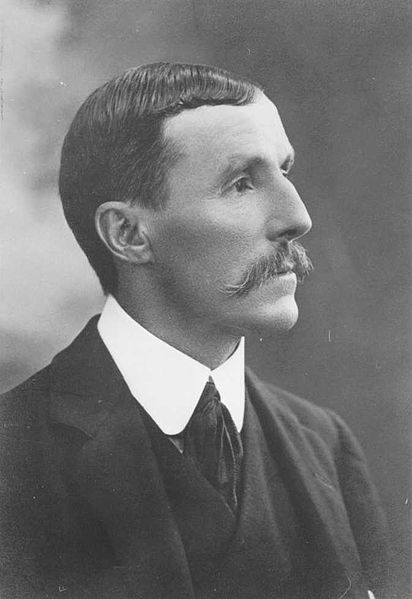
Pietro Baracchi, GMT astronomer, 1851-1926
After searching online, I located scans of his original notebooks on the National Archives of Australia website. I spend several days poring through Baracchi’s sketches and log entries, uncovering 58 discoveries. His predecessor Joseph Turner found 14 new objects and Albert Le Sueur 2 more.
To document his discoveries, Baracchi made careful diagrams including
nearby field stars. Sometimes he computed accurate positions (to within
a few arc-seconds) by timing offsets from known stars. As I suspected,
half of his discoveries were within galaxy clusters including 17 in the
Centaurus cluster (
His last discovery,
Let’s take a tour of some of my favorite GMT discoveries.
IC 4970 , a companion to the Condor Galaxy (NGC 6872 )
NGC 6872 is a remarkable gas-rich barred spiral, dubbed the Condor
galaxy, with enormous wings unfurling over 500,000 light-years from tip
to tip. This monster has a much smaller lenticular buddy, IC 4970, which
is tidally interacting. Both galaxies are flying within the
John Herschel missed IC 4970 when he discovered NGC 6872 in 1835, but Joseph Turner picked it up during an observation on August 27, 1881. The 1882 Annual Report of the observatory has a brief mention of the discovery, but Turner never received wider credit.
A stellar bridge connects IC 4970 with the Condor’s northern tidal arm at a break point referred to as the ‘knee’. IC 4970 may not look impressive – it’s only 1/10 to 1/5 as massive as NGC 6872 – but hosts an obscured active galactic nucleus (Seyfert 2). Astronomers propose a near collision with NGC 6872 drove gas to IC 4970’s supermassive black hole and fueled the AGN.
In 2014, Rafael Eufrasio (NASA Goddard) and colleagues analyzed the
star-formation regions in NGC 6872 in the far-ultraviolet to
near-infrared wavelengths. Their results showed the interaction with IC
4970 wasn’t solely responsible for shaping the Condor’s arms. A second
culprit is likely
Several years ago I viewed NGC 6872 through a 30-inch super-sized reflector. At 300×, it was a prominent oval, tipped 2:1 to the southwest toward a 10.4-magnitude star. The core was bright and elongated and held a vivid nucleus. The arms appeared as thin gossamer wings extending to the knee of the northern arm and beyond the bright star on the south side.
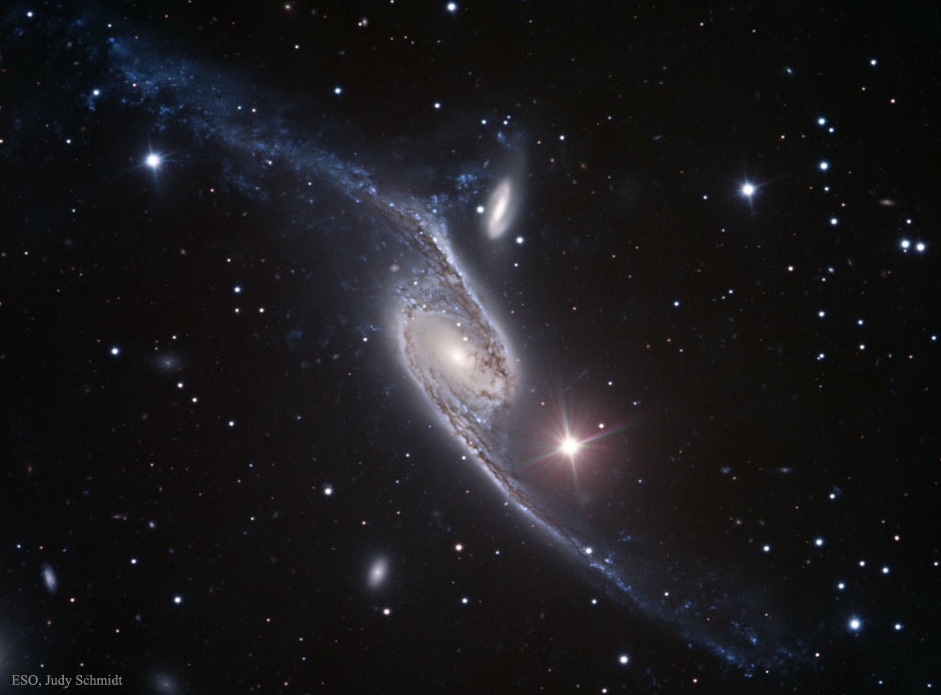
Credit: FORS Team, 8.2-meter, VLT Antu, ESO, Processing & License: Judy
Schmidt
Hodge 301 in the Tarantula Nebula (NGC 2070 )
Our next stop is the Tarantula Nebula NGC 2070, a spectacular
naked-eye star-forming complex in the LMC. At its massive heart is
Baracchi sketched the Tarantula Nebula on June 24, 1884, while still testing the telescope. Besides the central knot of stars and many intersecting loops of nebulosity, he included Hodge 301 as a compact circular patch, resolved into several stars. It wasn’t until 1988 that the University of Washington astronomer Paul Hodge first cataloged the cluster (one of 255 in the LMC).
Using an 18-inch reflector at 118× (also in Australia), the cluster stood out as a mottled 30” knot, just 3’ northwest of the Tarantula’s heart. Increasing to 225×, a half-dozen 13th to 14th magnitude stars sparkled over a hazy background.

Hodge 301 captured by the HST
NGC 6438A , disrupted companion to NGC 6438
NGC 6438 forms an interacting pair with a distorted irregular companion, known as NGC 6438A. This duo lies less than 5° from the south celestial pole in the constellation Octans. John Herschel discovered NGC 6438 from the Cape of Good Hope but only noted a single glow. Baracchi next observed the galaxy 50 years later. He described a “Double nebula… with a faint roundish flat appendage south following about 40” in diameter, which might be a close companion.” His sketch shows a bright, small nebula on the northwest side (NGC 6438) and a larger, fainter glow (NGC 6438A) attached to the southeast.
A 1996 photometric and spectroscopic investigation found strong differences between the northern wing and its southern tidal arm of NGC 6438A. The northern portion is very dusty and nearly forms a ring, while the southern extension is straight and less dusty, with a sharp definition. The authors conclude that NGC 6438A might be a merger of two disc galaxies, suggesting the system is an interacting triplet.1
Using a 24-inch scope at 260×, I found a strange-looking pair! The main galaxy was moderately bright, but small and round. NGC 6438A was larger but fainter – a diffuse wing or arc with no discernable core, spreading southwest to northeast. A 9.5-magnitude star (an uncatalogued double) sits 4’ southwest.

Image: Carnegie-Irvine Survey
Centaurus Galaxy Cluster (Abell 3526 )
The Centaurus galaxy cluster lies 9° northwest of Omega Centauri, the brightest globular cluster. It contains hundreds of galaxies that lie at a distance of some 130 million light-years. At a declination of -41°, the cluster scrapes the treetops from northern California, but I’ve still tracked down over 30 members.
Two months earlier Baracchi targeted
I had a breathtaking view of this galaxy through a 25-inch reflector at 244× in April 2019. My first impression was of a rather nondescript oval extending 30”×20” with a weakly condensed core. But with averted vision, thin perpendicular wings popped into view. Back to direct vision and they disappeared. Wow, a blinking polar ring galaxy!
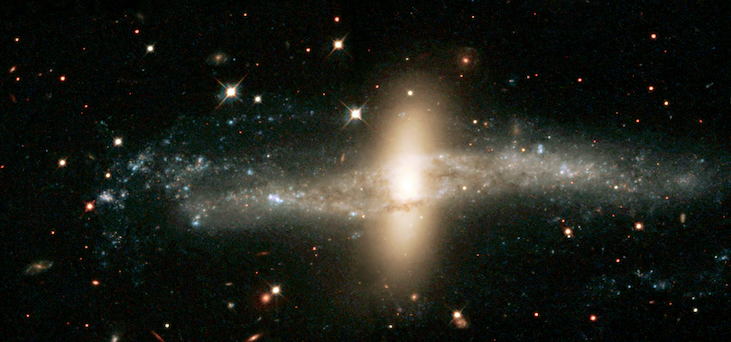
Hydra I Cluster (Abell 1060 )
The Hydra I cluster (S&T: April 2018, p. 30) resembles the Virgo cluster in both size and richness, though is three times as distant. The brightest of its 350 members shine at 12th magnitude and are visible in a 6-inch telescope.
John Herschel discovered the five brightest galaxies (
NGC 3312 is the largest and brightest spiral in the cluster. An
extensive dust structure winds around the disc and delineates a massive
outer spiral arm. When Baracchi sketched NGC 3312 he discovered two 14th
magnitude dwarfs that bookend the galaxy.
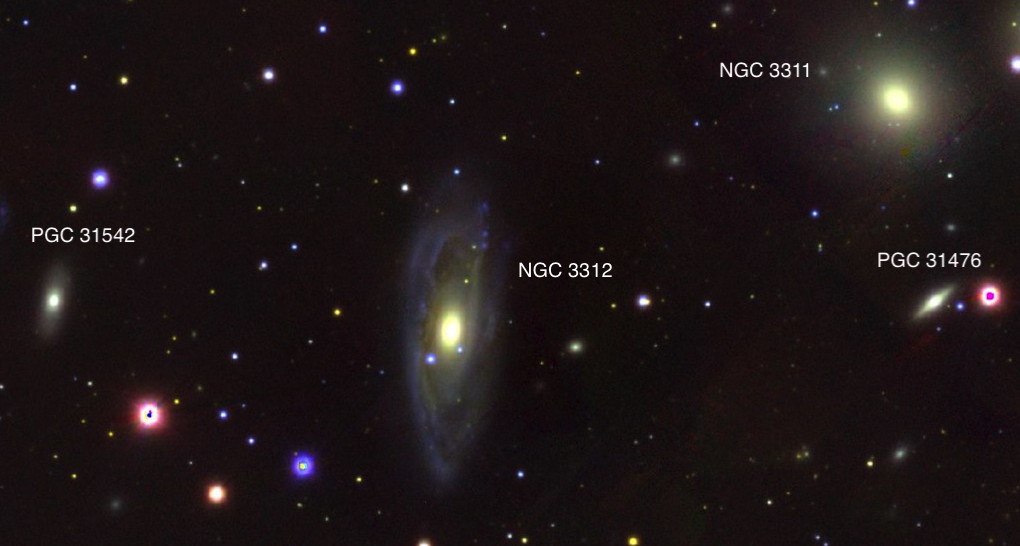
Antlia Cluster (ACO S 636 )
Our last stop is 8° further south at the Antlia Cluster, also a member of the Hydra-Centaurus Supercluster. With a declination of -36°, mid-northern observers should capture this loose cluster as it culminates on the meridian.
A perplexing question is its range of recessional velocities, with redshift surveys finding three concentrations around 1900 km/sec, 2800 km/sec, and 3700 km/sec. Is this a single cluster or several independent groups along the same line of sight? Although the galaxies with extreme velocities are likely in the foreground or background, the cluster appears to be strung out along a filament that points in our direction.3
Two giant ellipticals,
NGC 3258 also harbors a central supermassive black hole. In 2019, it was the focus of high-precision kinematical study using the Atacama Large Millimeter Array (ALMA). By modeling the high-velocity rotation of cold gas swirling around the black hole, astronomers measured its mass at a colossal 2.25 billion solar masses.5
John Herschel picked up 15 of the brightest cluster members from 11th to
13th-magnitude during several sweeps in 1834 and 1835. Over two nights
in 1886, Baracchi found six fainter members, including
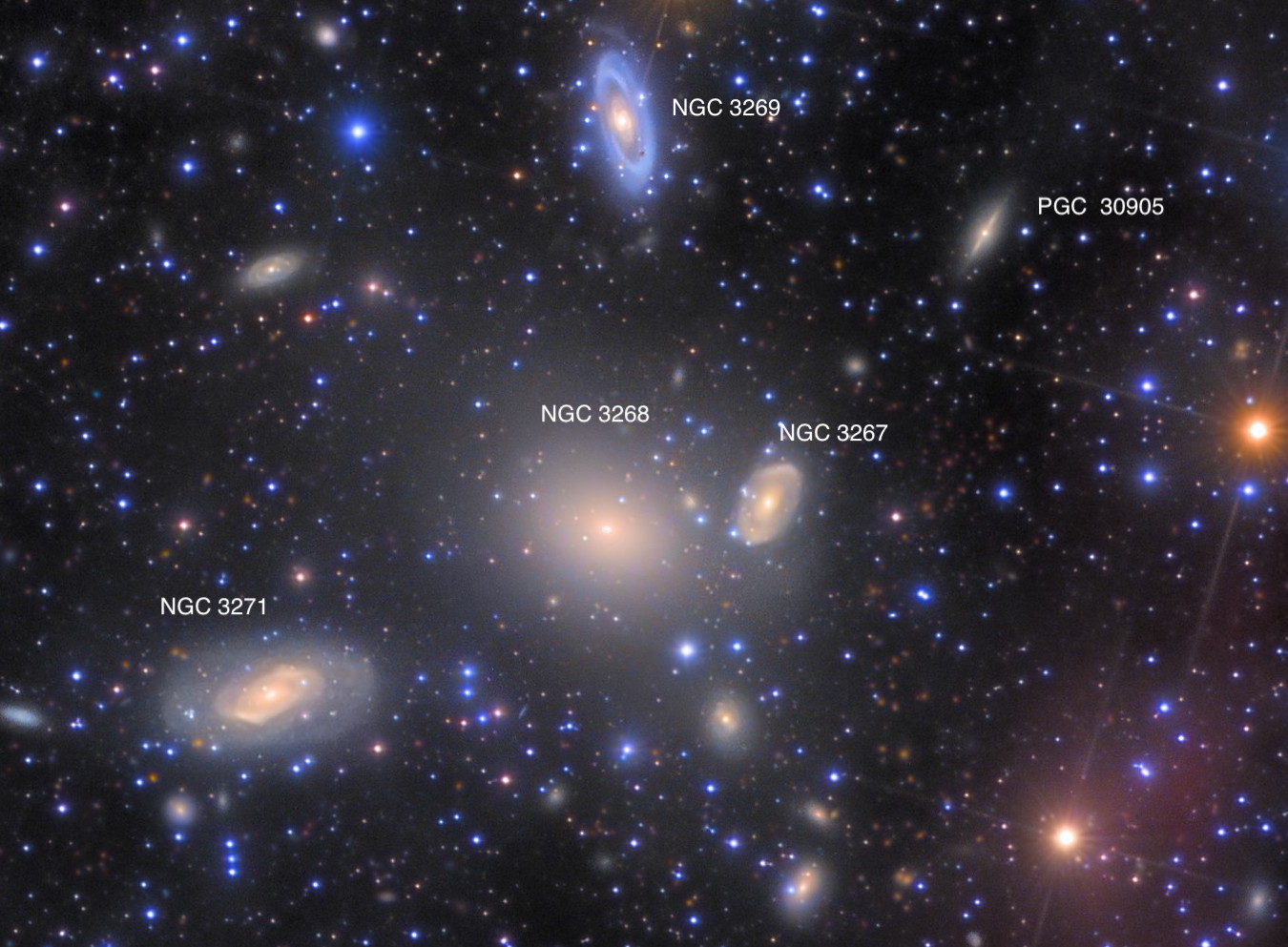
https://www.rolfolsenastrophotography.com/Astrophotography/Antlia-Galaxy-Cluster/
NGC 1200 Galaxy Group
NGC 1200 is the brightest member of a small galaxy group in western
Eridanus. William Herschel discovered this elliptical in November 1785
through his 18.7-inch speculum reflector. When his son John observed the
field 50 years later from the Cape of Good Hope, he also picked up
slightly fainter
Baracchi was at least the fourth observer to inspect the field on
December 7, 1885. After viewing Comet C/1885 X2, discovered four nights
earlier by E. E. Barnard, he turned the large telescope to NGC 1200.
Besides the three previously discovered nebulae, he noticed
NGC 1200 lies 3.6° southeast of 4th-magnitude Azha (Eta Eridani) at a
distance of 185 million light-years. The group also includes
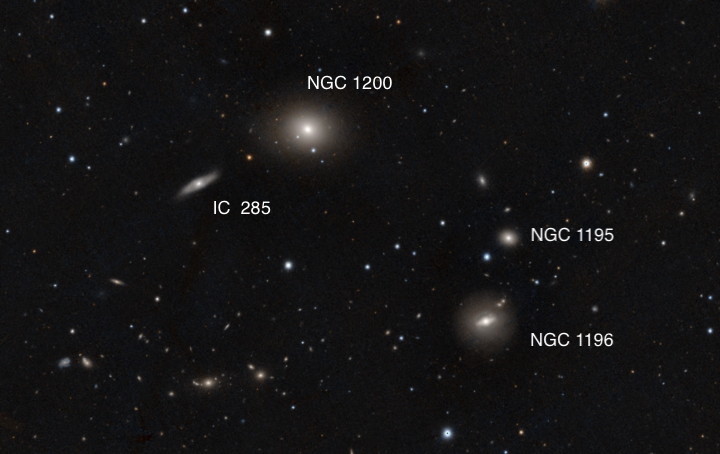
Image: PanSTARRS DR1
References
-
1996 paper by Donzelli and Espindola: “NGC 6438: A Triple System?” (http://articles.adsabs.harvard.edu//full/1996AJ….111.1057D/0001057.000.html) ↩
-
https://chandra.si.edu/photo/2017/ngc4696/ ↩
-
2015 study by Caso and Richtler: “Deconstructing the Antlia cluster core” (https://arxiv.org/pdf/1510.04274.pdf) ↩
-
2017 paper by Caso et al: “Globular cluster systems as tracers of the evolutionary history in NGC 3258 and NGC 3268” (https://arxiv.org/pdf/1812.09364.pdf) ↩
-
2019 paper by Boizelle et al: “A Precision Measurement of the Mass of the Black Hole in NGC 3258 from High-resolution ALMA Observations of Its Circumnuclear Disk” (https://arxiv.org/pdf/1906.06267.pdf) ↩